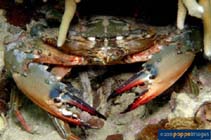Charybdis japonica (Milne-Edwards, 1861)
Japanese swimming crab
Classification / Names Common names | Synonyms | CoL | ITIS | WoRMS
| Decapoda | Portunidae
Environment: milieu / climate zone / depth range / distribution range Ecologia
Bentopelágico; intervalo de profundidade 0 - 50 m (Ref. 125642). Tropical
Distribuição Países | Áreas FAO | Ecossistemas | Ocorrências | Introduções
Western Pacific: from Japan to Malaysia. Subtropical and tropical climates.
Length at first maturity / Tamanho / Peso / Idade
Maturity: Lm ? range ? - ? cm Max length : 7.0 cm CW macho/indeterminado; (Ref. 343)
Descrição breve Morfologia
Carapace without transverse ridges behind last anterolateral tooth; frontal teeth acutely triangular; anterolateral all acutely triangular. Posterior border of propodus of legs serrated. Palm with 5sharp spines, longitudinal ridges on palm granulated. Color: carapace white with large greyish patches, tips at anterolateral teeth reddish brown; fingers red and white.
Subtropical and tropical climates (Ref. 343). Found intertidal to subtidal, on substrates ranging from seagrass, mud, sand, to rocks. Occur to depths of 50 meters (Ref. 125642). Also found in tidepools on rocky shores (Ref. 118296). Common in estuaries, in firm or muddy fine sands (Ref. 118295). Generalist scavenger and predator (Ref. 118296). Benthopelagic predator, feeding mainly on benthic bivalves (Lamellibranchia), benthic crustaceans, fishes, and cephalopods (Ref. 117071). Host to the sacculinid barnacle Heterosaccus papillosus (Ref. 118296).
Life cycle and mating behavior Maturidade | Reprodução | Desova | Ovos | Fecundidade | Larvas
Members of the order Decapoda are mostly gonochoric. Mating behavior: Precopulatory courtship ritual is common (through olfactory and tactile cues); usually indirect sperm transfer.
Referência principal
Referências | Coordenador | Colaboradores
Ng, P.K.L. 1998. (Ref. 343)
Categoria na Lista Vermelha da IUCN (Ref. 130435)
Categoria CITES (Ref. 108899)
Not Evaluated
CMS (Ref. 116361)
Not Evaluated
Ameaça para o homem
Utilização humana
| FishSource |
Ferramentas
Mais informação
Fontes da internet
BHL | BOLD Systems | CISTI | DiscoverLife | FAO(Publication : search) | Fishipedia | GenBank (genoma, nucleotídeo) | GloBI | Gomexsi | Google Books | Google Scholar | Google | PubMed | Árvore da vida | Wikipedia (ir para, procurar) | Registo zoológico
Estimates based on models
Categoria de preço
(Ref. 80766):
Unknown.



